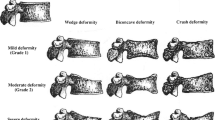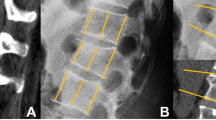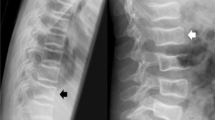Abstract
Summary
This study described a modified quantitative morphometry (mQM) system adapted to specific reference values for Mainland Chinese population. The mQM system is validated using the Genant Semiquantative system and is sensitive for detecting vertebral height changes and predicting cement leakage after percutaneous kyphoplasty (PKP) in patients with osteoporotic vertebral compressive fracture (OVCF).
Introduction
OVCF is a manifestation of osteoporosis. To improve clinical management of osteoporosis, the quantitative morphometry (QM) system has been widely used for the early diagnosis and precise classification of OVCF in developed countries. Here, we present an mQM system and validated its use in detecting OVCF in Mainland Chinese.
Methods
Using our mQM system, the pre- and post-operative values of vertebral heights were measured and evaluated in 309 Mainland Chinese who received percutaneous kyphoplasty (PKP) as OVCF treatment. Measurements and classification of fractures from the mQM system were validated by comparing to values obtained by the Genant semiquantative (SQ) method. Moreover, we evaluated the sensitivity of the mQM system by its ability to detect restoration of vertebral heights and predict cement leakage after PKP.
Results
The five classification of fractures, No deformity (ND), anterior wedge (AW), posterior wedge (PW), biconcavity (BC), and compression (CP), evaluated by the mQM method shared similar distribution characteristics compared to those obtained by the SQ method. In addition, mQM evaluation showed that the vertebra height of all fracture types showed significant restoration after PKP. The incidence of cement leakage was most common in CP (37.5%), followed by AW (31.6%), BC (26.5%), ND (23.7%), and PW (0.0%).
Conclusions
Our mQM system is suitable for classification of fractures, detection of vertebral height restoration, and correlation of cement leakage after PKP in Mainland Chinese population.





Similar content being viewed by others
References
Nayak S, Greenspan SL (2016) Cost-effectiveness of osteoporosis screening strategies for men. J Bone Miner Res 31(6):1189–1199. https://doi.org/10.1002/jbmr.2784
Schousboe JT (2016) Epidemiology of vertebral fractures. J Clin Densitom 19(1):8–22. https://doi.org/10.1016/j.jocd.2015.08.004
Zeytinoglu M, Jain RK, Vokes TJ (2017) Vertebral fracture assessment: enhancing the diagnosis, prevention, and treatment of osteoporosis. Bone 104:54–65. https://doi.org/10.1016/j.bone.2017.03.004
Pinheiro MM, Reis Neto ET, Machado FS et al. (2010) Risk factors for osteoporotic fractures and low bone density in pre and postmenopausal women. Rev Saude Publica 44 (3):479–485
Klotzbuecher CM, Ross PD, Landsman PB et al. (2000) Patients with prior fractures have an increased risk of future fractures: a summary of the literature and statistical synthesis. J Bone Miner Res 15 (4):721–739. https://doi.org/10.1359/jbmr.2000.15.4.721
Postacchini R, Paolino M, Faraglia S et al. (2013) Assessment of patient’s pain-related behavior at physical examination may allow diagnosis of recent osteoporotic vertebral fracture. Spine J 13 (9):1126–1133. https://doi.org/10.1016/j.spinee.2013.07.427
Clark EM, Gooberman-Hill R, Peters TJ (2016) Using self-reports of pain and other variables to distinguish between older women with back pain due to vertebral fractures and those with back pain due to degenerative changes. Osteoporos Int 27(4):1459–1467. https://doi.org/10.1007/s00198-015-3397-2
Upadhye S, Kumbhare D (2016) What are the most useful red flags for suspected vertebral fracture in patients with low back pain in the emergency department? Ann Emerg Med 67(1):81–82. https://doi.org/10.1016/j.annemergmed.2015.04.026
Freitas SS, Barrett-Connor E, Ensrud KE et al. (2008) Rate and circumstances of clinical vertebral fractures in older men. Osteoporos Int 19 (5):615–623. https://doi.org/10.1007/s00198-007-0510-1
Huang Z, Zhang L (2012) Treatment of osteoporotic vertebral compressive fractures with percutaneous kyphoplasty and oral Zishengukang. J Tradit Chin Med 32(4):561–564
Masala S, Cesaroni A, Sergiacomi G et al. (2004) Percutaneous kyphoplasty: new treatment for painful vertebral body fractures. In Vivo 18 (2):149–153
Yimin Y, Zhiwei R, Wei M et al. (2013) Current status of percutaneous vertebroplasty and percutaneous kyphoplasty—a review. Med Sci Monit 19:826–836. https://doi.org/10.12659/MSM.889479
Hoashi JS, Thomas SM, Goodwin RC et al. (2016) Balloon kyphoplasty for managing intractable pain in pediatric pathologic vertebral fractures. J Pediatr Orthop. https://doi.org/10.1097/BPO.0000000000000886
Noldge G, DaFonseca K, Grafe I et al. (2006) [Balloon kyphoplasty in the treatment of back pain]. Radiologe 46 (6):506–512. https://doi.org/10.1007/s00117-006-1384-5
Riesner HJ, Kiupel K, Lang P et al. (2016) Clinical relevance of cement leakage after radiofrequency kyphoplasty vs. balloon kyphoplasty: a prospective randomised study. Z Orthop Unfall 154 (4):370–376. https://doi.org/10.1055/s-0042-104069
Genant HK, Jergas M, Palermo L et al. (1996) Comparison of semiquantitative visual and quantitative morphometric assessment of prevalent and incident vertebral fractures in osteoporosis the study of osteoporotic fractures research group. J Bone Miner Res 11 (7):984–996. https://doi.org/10.1002/jbmr.5650110716
Ferrar L, Jiang G, Adams J et al. (2005) Identification of vertebral fractures: an update. Osteoporos Int 16 (7):717–728. https://doi.org/10.1007/s00198-005-1880-x
Eastell R, Cedel SL, Wahner HW et al. (1991) Classification of vertebral fractures. J Bone Miner Res 6 (3):207–215. https://doi.org/10.1002/jbmr.5650060302
McCloskey EV, Spector TD, Eyres KS et al. (1993) The assessment of vertebral deformity: a method for use in population studies and clinical trials. Osteoporos Int 3 (3):138–147
Smith-Bindman R, Cummings SR, Steiger P et al. (1991) A comparison of morphometric definitions of vertebral fracture. J Bone Miner Res 6 (1):25–34. https://doi.org/10.1002/jbmr.5650060106
Ning L, Song LJ, Fan SW et al. (2017) Vertebral heights and ratios are not only race-specific, but also gender- and region-specific: establishment of reference values for mainland Chinese. Arch Osteoporos 12 (1):88. https://doi.org/10.1007/s11657-017-0383-7
Yan L, He B, Guo H et al. (2016) The prospective self-controlled study of unilateral transverse process-pedicle and bilateral puncture techniques in percutaneous kyphoplasty. Osteoporos Int 27 (5):1849–1855. https://doi.org/10.1007/s00198-015-3430-5
Tome-Bermejo F, Pinera AR, Duran-Alvarez C et al. (2014) Identification of risk factors for the occurrence of cement leakage during percutaneous vertebroplasty for painful osteoporotic or malignant vertebral fracture. Spine (Phila Pa 1976). https://doi.org/10.1097/BRS.0000000000000294, 39, E700
Grados F, Fechtenbaum J, Flipon E et al. (2009) Radiographic methods for evaluating osteoporotic vertebral fractures. Joint Bone Spine 76 (3):241–247. https://doi.org/10.1016/j.jbspin.2008.07.017
Genant HK, Wu CY, van Kuijk C et al. (1993) Vertebral fracture assessment using a semiquantitative technique. J Bone Miner Res 8 (9):1137–1148. https://doi.org/10.1002/jbmr.5650080915
Black DM, Reiss TF, Nevitt MC et al. (1993) Design of the fracture intervention trial. Osteoporos Int 3 Suppl 3:S29–S39
Harris ST, Watts NB, Genant HK et al. (1999) Effects of risedronate treatment on vertebral and nonvertebral fractures in women with postmenopausal osteoporosis: a randomized controlled trial. Vertebral Efficacy with Risedronate Therapy (VERT) study group. JAMA 282 (14):1344–1352
Siris E, Adachi JD, Lu Y et al. (2002) Effects of raloxifene on fracture severity in postmenopausal women with osteoporosis: results from the MORE study. Multiple Outcomes of Raloxifene Evaluation Osteoporos Int 13 (11):907–913. https://doi.org/10.1007/s001980200125
Yang H, Pan J, Wang G (2014) A review of osteoporotic vertebral fracture nonunion management. Spine (Phila Pa 1976) 39 (26 Spec No.):B4–B6. https://doi.org/10.1097/BRS.0000000000000538
El Maghraoui A, Sadni S, El Maataoui A et al. (2015) Influence of obesity on vertebral fracture prevalence and vitamin D status in postmenopausal women. Nutr Metab (Lond) 12:44. https://doi.org/10.1186/s12986-015-0041-2
Greene DL, Isaac R, Neuwirth M et al. (2007) The eggshell technique for prevention of cement leakage during kyphoplasty. J Spinal Disord Tech 20 (3):229–232. https://doi.org/10.1097/01.bsd.0000211276.76024.30
Uri IF, Garnon J, Tsoumakidou G et al. (2015) An ice block: a novel technique of successful prevention of cement leakage using an ice ball. Cardiovasc Intervent Radiol 38 (2):470–474. https://doi.org/10.1007/s00270-014-0991-1
Corcos G, Dbjay J, Mastier C et al. (2014) Cement leakage in percutaneous vertebroplasty for spinal metastases: a retrospective evaluation of incidence and risk factors. Spine (Phila Pa 1976) 39 (5):E332–E338. https://doi.org/10.1097/BRS.0000000000000134
Wang C, Fan S, Liu J et al. (2014) Basivertebral foramen could be connected with intravertebral cleft: a potential risk factor of cement leakage in percutaneous kyphoplasty. Spine J 14 (8):1551–1558. https://doi.org/10.1016/j.spinee.2013.09.025
Zhu SY, Zhong ZM, Wu Q et al. (2016) Risk factors for bone cement leakage in percutaneous vertebroplasty: a retrospective study of four hundred and eighty five patients. Int Orthop 40 (6):1205–1210. https://doi.org/10.1007/s00264-015-3102-2
Ruiz Santiago F, Tomas Munoz P, Moya Sanchez E et al. (2016) Classifying thoracolumbar fractures: role of quantitative imaging. Quant Imaging Med Surg 6 (6):772–784. https://doi.org/10.21037/qims.2016.12.04
Acknowledgments
The authors thank Dr. Jasper H.N. Yik from the University of California, Davis, for editing this manuscript.
Funding
The authors thank the National Natural Science Fund of China (grant No: 81501912) and Zhejiang Provincial Natural Science Foundation of China (grant No: LQ15H060001) to Zi’ang Hu, as well as the National Natural Science Fund of China (grant No: 11701509) and China Postdoctoral Science Foundation (grant No: 2017M612021) to Li-Li Wang.
Author information
Authors and Affiliations
Corresponding author
Ethics declarations
Conflicts of interest
None.
Rights and permissions
About this article
Cite this article
Song, LJ., Wang, LL., Ning, L. et al. A modification and validation of quantitative morphometry classification system for osteoporotic vertebral compressive fractures in mainland Chinese. Osteoporos Int 29, 2495–2504 (2018). https://doi.org/10.1007/s00198-018-4641-3
Received:
Accepted:
Published:
Issue Date:
DOI: https://doi.org/10.1007/s00198-018-4641-3




